Pimp my Melodica
- This topic has 8 replies, 4 voices, and was last updated 5 years, 4 months ago by
 Lowboy.
Lowboy.
-
AuthorPosts
-
November 28, 2018 at 9:25 am #10541
 DarenKeymaster
DarenKeymasterI’m embarking on a fun project at the workshop – customising one of my favourite melodicas, the Yamaha P37D. I’ve always enjoyed playing Yamaha melodions, they have a warm tone, and the reeds are some of the best quality available of the cheaper ‘harmonica style’. Most of us melodica builders tend to use single, accordion style reeds when building from scratch, for the tone quality and stability of intonation. But I’ve got to say, nothing beats the expression, playability and fun of cheap melodica reeds!
There’s a few issues with the P37D which I can fix here, as well as making it generally look much better. Issue no.1 has to be the moisture release valve, which is operated with a spring loaded button. Nothing terrible about that, apart from it dumps all of the moisture into the inside of the case! This will find its way out eventually through the vent holes, or by evaporation. Not the most elegant of solutions here. I’m planning to replace the whole mechanism with a screw cap – which can be left off for most of the time, while not playing, to allow a flow of air through the instrument, keeping the reeds as dry as possible.
The second issue is something that anyone who practices hours a day knows, the white keys wear away, until there’s little holes in some of the most used keys. I’m planning to clad the keys in aluminium sheet, which will stop the wear, and also look much better than plastic.
The third issue is the plastic case. There’s actually not much wrong acoustically with using a plastic case, it does a good job of amplifying the sound, and producing a reasonably warm tone. But improvements can definitely be made – with various woods, different timbral qualities can be achieved. Mahoganies, Rosewoods, spruce or cedar all have their own qualities. Melodica reeds can sound a little shrill, especially at the upper end, so I’m going to look at balancing that up a bit with a warm sounding timber.
November 28, 2018 at 6:13 pm #10545 Alan BrintonParticipant
Alan BrintonParticipantYour projected improvements all sound good, Daren. I’m wondering about what you have in mind for the case, which basically means the plastic tray and the end pieces. Will this be entirely replaced with a wooden enclosure. I have found in transplanting my old P-37D into the (thicker and I suspect more porous) enclosure of the new P-37E (which also has a rubberized strip in it) that the sound is significantly changed, so as to be very similar to that of the P-37E.
The thickness of the wooden enclosure (or enclosure surfaces) will probably make a big difference, with a thick surface tending to deaden the sound and a thinner surface providing resonation, as happens with a guitar or other stringed instrument. The thick wooden enclosure of a Mylodica, for example, is not much of a resonation chamber. I suspect that the same is true with the new Suzuki wooden models. Is it possible to configure your pimped up model so it has a meaningful wooden resonation chamber?
November 29, 2018 at 4:08 am #10549 Melodica-MeParticipant
Melodica-MeParticipantDaren, are you going to polish and coat the aluminum as it will turn your fingers black if not coated. You may want to find some anodized aluminum sheets, that will take care of any issues as well.
I think aluminum keys and Wenge exotic hardwood would look stunning.
Melodica-MeNovember 30, 2018 at 3:33 pm #10550 DarenKeymaster
DarenKeymasterAlan, I’ll be making a whole new case with 4mm timber. I’ve experimented with thicker timber, but as you say, it tends to deaden, rather than resonate. I’ve found it has to be quite thin and light, to effectively amplify the sound.
I have a selection to get through, bit I’m not sure which one I’ll end up choosing for this one. Some woods are more stable than others at that thickness, which means they’re more likely to stay in the shape that I make them. My ebony instrument is quite loud and bright, and very stable. I’ve also made a zebrawood melodica (with single reeds) which both looks and sounds great. This has also stood the test of time (about a year so far). I only made this because I found a rare piece of thin zebrawood which wasn’t warped.
MM, the keys are galvanised aluminium, so hopefully they won’t turn my fingers black, but if they do, I can always coat them. Wenge’s lovely, but I think it would sound too bright for this one. I may well choose Mahogany this time, for the warm sound, though it’s not the most interesting timber to look at.
I’ve got some photos to post now, but I’m waiting for the technician to sort out some issues with the site before I can post…
November 30, 2018 at 4:34 pm #10551 Alan BrintonParticipant
Alan BrintonParticipantYou probably are already aware of The Ukulele Site, Daren, but just in case…. I bought a uke from their store and in the process was exposed to quite a lot of fascinating information about the various kinds of exotic wood that are used and how the choice is related to the kind of sound the instrument produces and about advantages & disadvantages. I bought from them because of their reputation for screening the instruments and then individually setting each one up.
December 2, 2018 at 8:11 am #10555 Melodica-MeParticipant
Melodica-MeParticipantDaren, what does galvanized aluminum look like, I have never seen that before. I know what galvanized steel looks like. does it have the similar finish. I did not know that process was possible on aluminum.
Melodica-MeDecember 13, 2018 at 9:59 am #10570 DarenKeymaster
DarenKeymasterHere’s some photos MM. They also polish up to a shiny finish, but I think I’ll keep them like this.
I took measurements from the P37D keys, using a digital calliper, and made some 2D files to send to the last cutters. I’ve used Lasered Components (in the UK) for a previous job, and went with them again for this. I got enough done for 3 new instruments, just in case I might need some in the future. They arrived in one big sheet, with a thickness of 0.9mm:
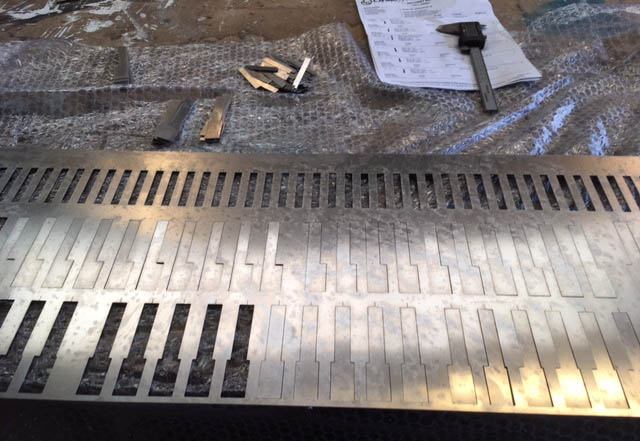
Then I sorted out the keys into separate piles:

Next, I scuffed up one side of the aluminium plate, using a small needle file, so it would adhere well to the plastic melodica key. I did the same to the plastic:

I used superglue gel to stick them together. The ends of the keys needed rounding off to fit the plastic key. I used a disc sander for this. It had to be done at an angle, as the front of the keys are slightly angled:
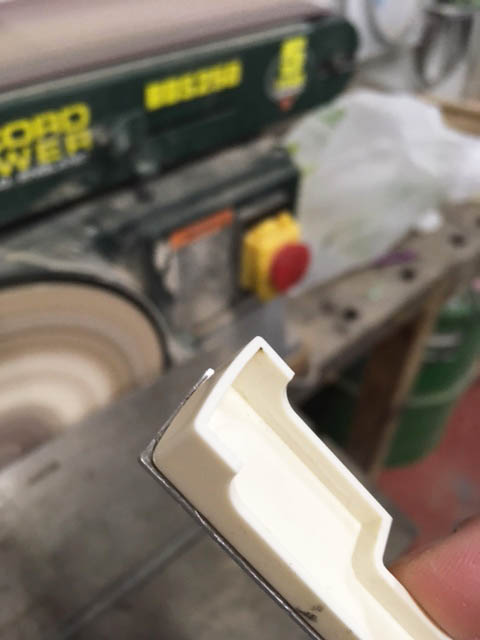
I used sandpaper to make sure the edges of the aluminium and the keys were smooth:

The corners of the aluminium sheet were a bit rough, so I smoothed them down with a deburring scraper:
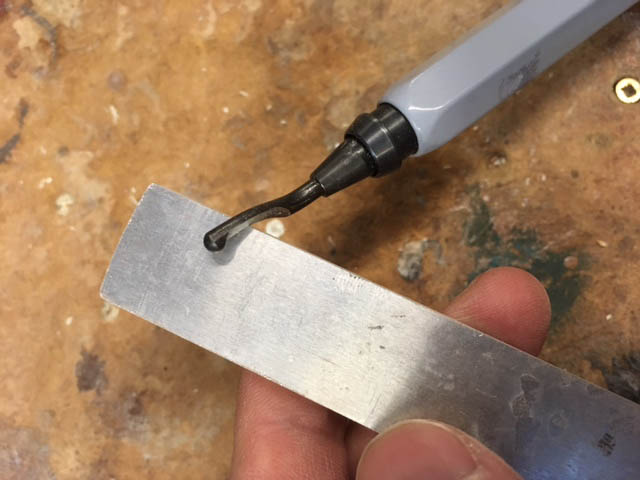
I tested 2 keys with different finishes – one I painted with silver paint (Revell Aqua Color Acrylic), and the other I used a black marker, the black marker looked best to me:
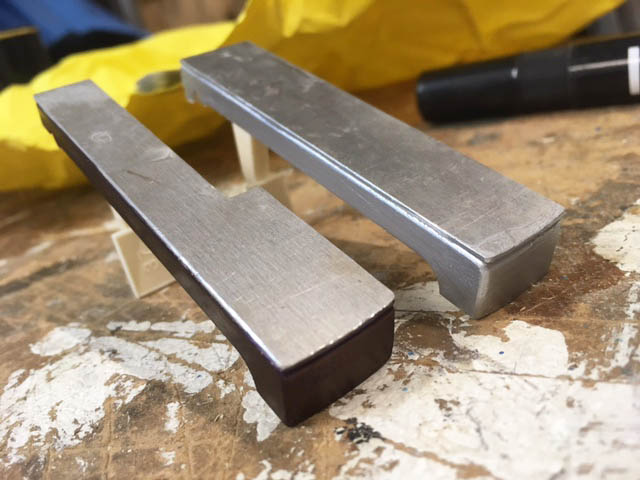
And here they are, back on the instrument. I was planning to coat the black keys too, though they’re not easy to do, as they’re not flat. I like the way it looks like this though:
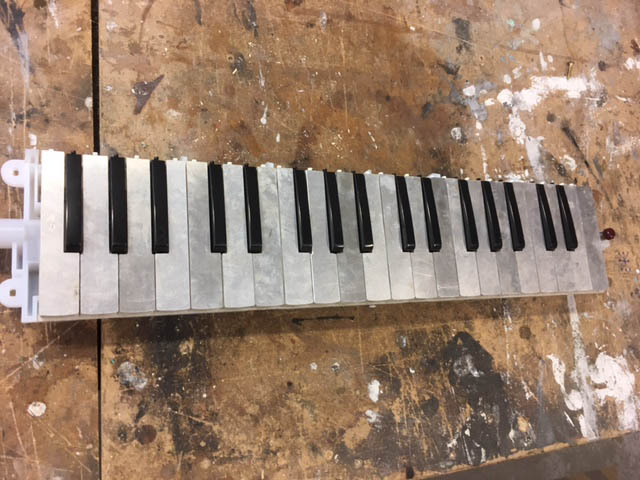 December 13, 2018 at 10:55 pm #10572
December 13, 2018 at 10:55 pm #10572 Melodica-MeParticipant
Melodica-MeParticipantDaren, I like the contras between black keys and metal keys. I think that was a good decision. Maybe you can anodize the extra keys you had made in a bronze-brass finish and go for a steam punk look on your next melodicas project :).
Melodica-MeDecember 15, 2018 at 12:15 pm #10580 LowboyParticipant
LowboyParticipantMetal mother of pearl
-
AuthorPosts
- You must be logged in to reply to this topic.
